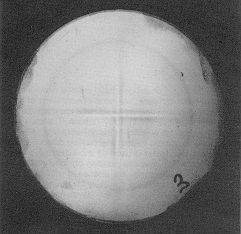Common Defects Found When Spin Coating
This is by
no means an exhaustive list, but I try to highlight a number of defects/features
that are characteristic of spin coated films.
Comets: These usually
occur when relatively large solid particles impede the normal flow patterns
of the solution on the spinning wafer. Except during "spin up", the flow
is normally smooth and radial in nature (having a gradient in radial velocity
governed by the applicable force balances and viscosity constraints (see
spin coating basics page). The presence of comets can be reduced or
eliminated by working in cleaner environments and by filtering coating
solutions as part of the dispense process.
Each of the figures below can be ZOOMED by clicking in the figure area
for 2.5X enlargements. In all cases the flow was from left to right and
the scale is the same for all photos. All are light microscopy photos so
color differences indicate different coating thickness at different locations.
These coating differences are most dramatic for the photo on the right.
Striations:Striations
are radially oriented lines of thickness variation in the as-coated film.
Usually they are quite smoothly varying thickness variations with a spacing
or periodicity in the 50-200 micron range, or so. Their orientation corresponds
the direction of major fluid flow (which is running horizontally in
2 of the 3 the optical micrographs shown below). Their occurance is
thought to arise because of evaporation driven surface tension effects.
The early evaporation of light solvents can cause an enrichment of water
and/or other less volatile species in the surface layer. IF, the surface
tension of this layer is larger than the starting solution (and what still
exists at deeper levels), then an instability exists where the higher surface
tension actually draws material in at regular intervals and the spaces
in-between are more able to evaporate, and surface relief develops. This
is essentially due to the Marangoni effect which governs the development
of structures in the drainage patterns of wine down the sides of a wine
glass: ethanol evaporates first leaving an ethanol-depleted wine layer
that gathers into rivulets and drains down the glass wall.
Evaporation driven surface tension effects can create
striations the following way:
The evaporation process makes the top layer have a different
composition and therefore a different surface tension. The top surface
then can become unstable to "long wavelength" perturbations that grow unstably.
The exact conditions that control what is stable and what is unstable are
still not well known. Our preliminary model is that you would like the
evaporation process to be driving the local surface tension to lower values
and that this would tend to stabilize the system. This is currently being
tested on a number of sol-gel and polymer coating systems.
 Chuck
Marks: These patterns
can be created by thermal "communication" between the solution on top of
the wafer and the metal vacuum chuck on the back side of the wafer (see
Chuck Marks page for more detailed explanation). Thus, the thermal
conductivity of the substrate material is very important as is the thermal
driving force (mainly evaporative cooling, but could also be due to temperature
differences between solution and substrate and chuck....). The figure
at right has a single layer sol-gel-derived coating on a glass substrate.Silicon
wafers, because of their higher thermal conductivity, will usually have
smaller thickness differences compared to glass or plastic.
Chuck
Marks: These patterns
can be created by thermal "communication" between the solution on top of
the wafer and the metal vacuum chuck on the back side of the wafer (see
Chuck Marks page for more detailed explanation). Thus, the thermal
conductivity of the substrate material is very important as is the thermal
driving force (mainly evaporative cooling, but could also be due to temperature
differences between solution and substrate and chuck....). The figure
at right has a single layer sol-gel-derived coating on a glass substrate.Silicon
wafers, because of their higher thermal conductivity, will usually have
smaller thickness differences compared to glass or plastic.
Environmental Sensitivity: When making coatings in the ambient environment, it is possible for the surroundings to have an influence on the coating quality. One critical variable is the humidity of the surrounding air. For many solutions, water can play an important role in the chemistry of the solution itself, so when varying amounts of water are present in the surroundings then varying coating quality can result. This can manifest itself as coating roughness, microcracking of the coating upon further drying, exaggerated striation formation in the coating, etc. Obviously, close control of the environment around the spin coater is crucial.
Wafer Edge Effects: The edges of the substrate will always be areas of concern. If better uniformity can be maintained out to the edges then more area can be used for device fabrication. The edges are problems for several reasons. First, surface tension effects make it difficult for solution that is flowing radially outward to detach from the wafer. Thus a small "bead" of liquid can stay attached around the entire perimeter and result in thicker coatings in this rim zone. In addition, if substrates are not exactly round and especially if they are square or rectangular, then the air flow over the protruding parts (corners) will be perturbed. Although the flow may still be laminar, it will have different flow history and will usually result in non-uniformity in coating thickness in these corner areas.